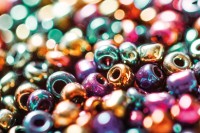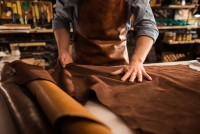Welcome to TFL’s new Colour Trend Catalogue for the season Spring-Summer 2024. In this brochure we present the colour trends for leather garment, footwear, accessories and upholstery.
Wearing
Leather is not always the first choice of young consumers. The leather industry needs to adapt itself to this and we have to make the material more attractive again. Because it actually has so many attributes young consumers are looking for: it is sustainable,contributing to circular economy, very durable and has a natural beauty. With the TFL PURE range for example TFL is promoting products that enable real natural leathers – and that feels good. Also further digitalisation – in the leather manufacturing process itself and in marketing the final leather goods - can contribute to make the material more attractive again – also for younger generations.
In this collection TFL is featuring these beneficialcharacteristics of leather:
- grain elasticity
- anti-ageing finishes
- sustainability and neo-vegetable
The elasticity of the leather can be achieved in the pickling phase by means of new tanning and retanning products and an accurate process. The leather is transformed into an innovative material that keeps its shape, perfect for sheathing complex or aerodynamic shapes that evoke the idea of speed, thereby coining a new term: “fast leather”.This feeling of wearing a protective second skin also opens doors for new opportunities for the leather clothing industry and revolutionises how designers think having a more attractive, modified material to work with. Just imagine how it would feel to cover yourself with a casing or second skin or be able to change and adapt it to another shape or situation. One day in the future we may enjoy “tapes” made from leather, enabling us to merge material and organism.
Anti-ageing finishes. Vintage, ripped and stained are trends that we have seen repeatedly year after year, but now as part of this great chemical-creative-applicative endeavour we can focus on the concept of relaxing, pleasurable functionality.
Sustainability has become one of the most important topics inour modern world. TFL is constantly upgrading its PURE range based on renewable materials enabling our customers to calculate the bio-content of their receipes.
With regards to tanning, the future vision is that every tannery could be a tiny power plant that throws away nothing and reuses everything, starting by continuously recycling water to even create tanning products that reactivate this material in perpetuity.One step in this direction is the TFL offer of the modular insitu production plant enabling tanneries to upcycle their by-productsto bio-stimulants and oil.
Living
As the conventional room layout in our homes and communal areas gradually moves further away from their original definitions and functions, hybrid spaces are generated that provide a transitional breeding ground for exploring and innovating new projects. Wherever we look, we find co-working spaces, homes incorporating workstations and offices, apartments framed by trees and plants symbiotically conversing with architectural elements, and ever-more hybridised, multitasking furniture.
As our houses and homes continue to fragment, the part of the leather industry that produces leather for interiors must change the pace of its conventional, collections as they no longer inspire us to explore new horizons, and focus on:
- the frisson of colour
- the lightness of leather
Now let’s take a closer look at the two macro trendsand the targets each feature.
The tanning industry can produce the desired frisson of colour with two types of tanning products. Traditional chrome for cleaner, more faded colours through to clean shades of beige, ecru, ivory and grey, and synthetic-based tanning products that are naturally white and transparent enough to produce the “Instagram” colours, such as deep tones of electric blue and fuchsia that are bright and reflective enough to stimulate the imagination of the audience on the screens of their various devices.
Playing leading roles in this world are:
- Nappa with a 1.2 / 1.4 thickness weighing 68 / 72g per square foot using bovine leathers that are spun at the end of the process to loosen the leather’s structure even after it has been finished.
- “Sponge” effect nubuck for zebu and all buffalo hides created by splitting the grain in wet-blue so the leather is dyed deep down to the roots even for thicker leathers of 1.6 / 1.8 weighing 78 / 80g per square foot. This works for everything from the highest quality to cheaper leathers, creating an attractive look with a nod to the world of videogames, such as Fortnite or Minecraft. Preferred targets are interlocking modular systems, particularly geometric shapes and even peanut shapes to create a more dynamic, extended puzzle.
Lightness, namely the specific weight of the leather, is the second key subject, especially at a time when logistics has seen a steep hike in costs. Consequently, any products or goods that are light are more easily transportable and increase in value, demanding R&D departments to source new chemical products and innovative applications.





 Main Reaction - The TFL Blog Stories, incidents, tips and facts around the topics leather, chemistry, fashion, sustainability and ecology. Our editorial staff consisting of experienced tanners, scientists, market experts, fashion and communication specialists has sharped their pencils and will supply you with fresh and inspiring content on a regular basis.
Main Reaction - The TFL Blog Stories, incidents, tips and facts around the topics leather, chemistry, fashion, sustainability and ecology. Our editorial staff consisting of experienced tanners, scientists, market experts, fashion and communication specialists has sharped their pencils and will supply you with fresh and inspiring content on a regular basis.


 LEVOTAN® / LUBRITAN™ - Looking for higher performance? Tanners around the world are facing increasing challenges from their customers, for example, demands for higher performance such as fastness to light and heat resistance, but also lighter weight leather and more recently odour / emissions avoidance.
LEVOTAN® / LUBRITAN™ - Looking for higher performance? Tanners around the world are facing increasing challenges from their customers, for example, demands for higher performance such as fastness to light and heat resistance, but also lighter weight leather and more recently odour / emissions avoidance.










